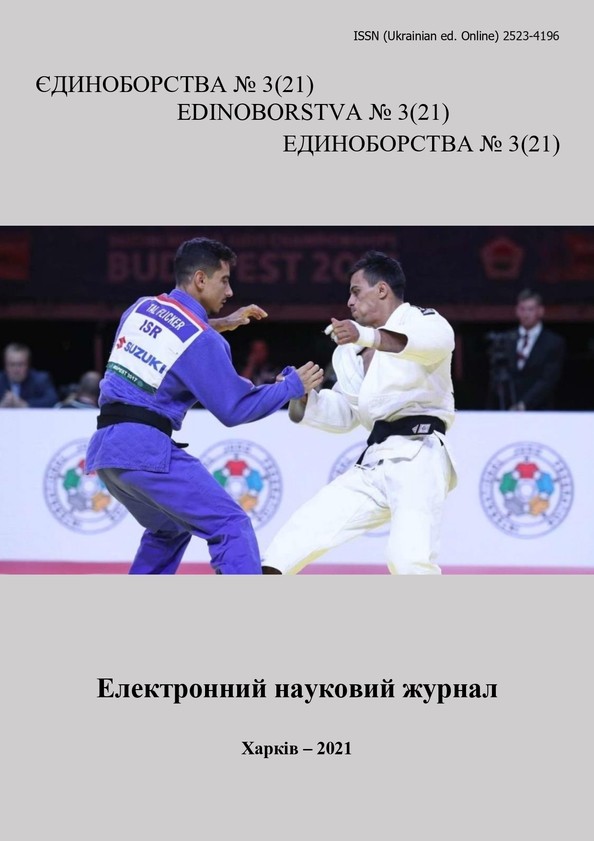Analysis of selection for wrestling for the Olympic Games in Tokyo
DOI:
https://doi.org/10.15391/ed.2021-3.08Keywords:
selection system, Olympic license, wrestling, Olympic Games, stage, country, continent, qualifying tournamentAbstract
Purpose: to analyze the qualification requirements for athletes to obtain Olympic licenses to participate in the XXXII Olympic Games in Tokyo in
wrestling. Materials and methods of research. Research methods: theoretical analysis and generalization of literature data and the Internet, methods of mathematical statistics. The initial results of the performances are taken from the official website of the International Wrestling
Federation (United World Wrestling) (https://uww.org/). MS Excel was used for statistical data processing and graphical presentation of results. Results: it is established that according to the requirements of the IOC in wrestling competitions at the Summer Olympics in Tokyo can participate no more than 288 athletes (16 wrestlers in 12 weight categories in men's competitions and 16 participants in six weight categories in women's competitions). For the right to participate in the Olympics in wrestling, a rather intense selection was carried out, which included several
stages. It was found that none of the strongest «wrestling» countries in the world has obtained the maximum number of licenses (18) for the Olympics. Russia has obtained 17 licenses, the United States – 15, 12 – from Cuba and Japan, 11 – in Iran, Kazakhstan and China, 10 – in Tunisia and
Ukraine. 10 or more participants will represent the 9 strongest «wrestling» states at the Olympics, which amounted to 37,85 % of all wrestlers. In total, the right to participate in the Olympics was won by representatives of 62 countries. Representatives of 14 countries obtained 52,43 % of
licenses. 20 countries will be able to put only one athlete at the Olympics, despite the fact that they include countries that have a long wrestling tradition. However, small countries have also won tickets to the Olympics, which testifies to the popularization of the struggle and the expansion of its
geography in the world. The largest number of tickets to the Olympics in Tokyo traditionally won the representatives of Europe – 122 licenses (42.36%), they lost to wrestlers from Asia – 84 licenses (29,17 %), much fewer licenses from the representatives of America – 44 (15,28 %), Africa and
Oceania – 38 (13,19 %). Conclusions. Limiting the number of wrestlers participating in the Olympics forces wrestling experts to be in constant search of the optimal system of selection of athletes, and such selection should, firstly, ensure the participation in the Olympics of all the strongest wrestlers on the planet and, secondly, give equal rights to different countries and continents in competition for this participation. The postponement of the Summer Olympics in
Tokyo to 2021 due to the coronavirus pandemic made adjustments to the qualification selection calendar and affected the results of the selection itself. All this together had a negative effect on the efficiency of selection, and a significant part of high-class wrestlers were not able to qualify for the Olympics.
References
Апойко, Р.Н. (2016). Эволюция спортивной борьбы в международном олимпийском движении и ее влияние на основные компоненты подготовки борцов высшей квалификации (Автореф. дис. … д-ра пед. наук). Санкт-Петербург, Россия.
Апойко, Р.Н., & Тараканов, Б.И. (2015). Спортивная борьба: эволюция, тенденции, проблемы и приоритетные пути их решения : монография. СПб. : Изд-во Политех. Ун-та
Бойченко, Н.В., Чертов, І.І., Пирог, Ю.А., & Алексєєв, А.Ф. (2020). Аналіз показників змагальної діяльності висококваліфікованих дзюдоїсток легких вагових категорій. Єдиноборства, 4-12.
Булатова, М.М. (2017). Боротьба. Енциклопедія в запитаннях і відповідях. Навчальне видання. Олімпійська література, Київ.
Дагбаев, Б.В. (2013). Подготовка борцов вольного стиля с учетом современных правил соревнований: монография. Улан-Удэ.
Задорожна, О.Р., Бріскін, Ю.А., Пітин, М.П., Потоп, В., Гращенкова, Ж.В., Глухов, І.Г., & Дробот, К.В. (2020). Особливості комплектування складу учасників Ігор ХХХІІ
Олімпіади 2020 у Токіо (на прикладі спортивних єдиноборств). Український журнал медицини, біології та спорту, Том 5, № 3(25), 445-449. https://DOI:10.26693/jmbs05.03.445
Латишев, Н., Шандригось, В., Тропин, Ю., Квасница, О., & Головач, И. (2020). Женская борьба: анализ результатов выступления сборной команды Украины. Фізична культура, спорт та здоров’я нації: збірник наукових праць, Вип. 9(28). 237-243. https://DOI:10.31652/2071-5285-2020-9(28)-237-243
Леннарц, К. (2013). Спортивная борьба в системе олимпийского спорта. Наука в олимпийском спорте, 4, 4-7.
Приступа, Є., Бріскін, Ю., Палатний, А., & Пітин, М. (2017). Розвиток та становлення спортивних єдиноборств у програмах Ігор Олімпіад сучасності. Фізична активність, здоров'я і спорт, №1(27), 3-19.
Тропин, Ю.Н., Панов, П.П., & Фазилов, Р.К. (2017). Анализ выступлений украинских борцов греко-римского стиля в лицензионных соревнованиях на Олимпийские игры 2016 года. Единоборства, №2(4), 52-55.
Чертов, І.І., Бойченко, Н.В., Зантарая, Г.М., & Мирошниченко, Є.С. (2021). Аналіз показників змагальної діяльності лідируючих дзюдоїсток вагової категорії до 52 кг. Єдиноборства, 69-78.
Шандригось, В.І. (2018). Cистемно-історичний аналіз досягнень країн-учасниць в змаганнях з вільної боротьби на Олімпійських Іграх (1904-2016 рр.). Єдиноборства, №1(7), 89-97.
Шандригось, В.І. (2019). Динаміка кількості вагових категорій борців вільного стилю в програмах Олімпійських ігор. Єдиноборства, №2 (12), 58-67. https://DOI:10.5281/zenodo.2544680
Шандригось, В.І., Латишев, М.В., Первачук, Р.В., & Яременко В.В. (2020). Аналіз результатів виступів збірної команди України з жіночої боротьби. Єдиноборства, №4(18), 90-104 https://DOI:10.15391/ed.2020-4.09
Шандригось, В.І., Латишев, М.В., Розторгуй, М.С., & Первачук Р.В. (2021). Динаміка кількості вагових категорій в жіночій боротьбі. Єдиноборства, №1(19), 79-89, https://DOI:10.15391/ed.2021-1.08.https://olympics.com/ioc/news/joint-statement-from-the-international-olympic-committee-and-thetokyo-2020-organising-committee– [Електронний ресурс]. – Режим доступуhttps://olympics.com/ (дата звернення: 01.05.2021).
https://uww.org/sites/default/files/2021-03/210226_revised_qualification_system_-_wrestling_-_eng.pdf– [Електронний ресурс]. – Режим доступу https://olympics.com/ (дата звернення: 01.05.2021).













